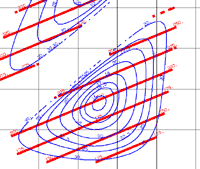
Porkchop plot
Encyclopedia

Characteristic energy
In astrodynamics a characteristic energy , a form of specific energy, is a measure of the energy required for an interplanetary mission that requires attaining an excess orbital velocity over an escape velocity required for additional orbital maneuvers...
(C3) against combinations of launch date and arrival date for a particular interplanetary flight.
By examining the results of the porkchop plot, engineers can determine when launch opportunities exist (a launch window
Launch window
Launch window is a term used in spaceflight to describe a time period in which a particular launch vehicle must be launched. If the rocket does not launch within the "window", it has to wait for the next window....
) that is compatible with the capabilities of a particular spacecraft. A given contour, called a porkchop curve, represents constant C3, and the center of the porkchop the optimal minimum C3. The orbital elements
Orbital elements
Orbital elements are the parameters required to uniquely identify a specific orbit. In celestial mechanics these elements are generally considered in classical two-body systems, where a Kepler orbit is used...
of the solution, where the fixed values are the departure date, the arrival date, and the length of the flight, were first solved mathematically in 1761 by Johann Heinrich Lambert
Johann Heinrich Lambert
Johann Heinrich Lambert was a Swiss mathematician, physicist, philosopher and astronomer.Asteroid 187 Lamberta was named in his honour.-Biography:...
, and the equation is generally known as Lambert's problem (or theorem).
Math
The general form of Characteristic Energy can be computed as:
where
 is the orbital velocity
is the orbital velocityOrbital speed
The orbital speed of a body, generally a planet, a natural satellite, an artificial satellite, or a multiple star, is the speed at which it orbits around the barycenter of a system, usually around a more massive body...
when the orbital distance tends to infinity. Note that, since the kinetic energy is one half m
 C3 is in fact equal to twice the magnitude of the specific orbital energy
C3 is in fact equal to twice the magnitude of the specific orbital energySpecific orbital energy
In the gravitational two-body problem, the specific orbital energy \epsilon\,\! of two orbiting bodies is the constant sum of their mutual potential energy and their total kinetic energy , divided by the reduced mass...
(
 ) of the escaping object.
) of the escaping object.Use
For the Voyager programVoyager program
The Voyager program is a U.S program that launched two unmanned space missions, scientific probes Voyager 1 and Voyager 2. They were launched in 1977 to take advantage of a favorable planetary alignment of the late 1970s...
, engineers at JPL plotted around 10,000 potential trajectories using porkchop plots, from which they selected around 100 that were optimal for the mission objectives. The plots allowed them to reduce or eliminate planetary encounters taking place over the Thanksgiving
Thanksgiving
Thanksgiving Day is a holiday celebrated primarily in the United States and Canada. Thanksgiving is celebrated each year on the second Monday of October in Canada and on the fourth Thursday of November in the United States. In Canada, Thanksgiving falls on the same day as Columbus Day in the...
or Christmas
Christmas
Christmas or Christmas Day is an annual holiday generally celebrated on December 25 by billions of people around the world. It is a Christian feast that commemorates the birth of Jesus Christ, liturgically closing the Advent season and initiating the season of Christmastide, which lasts twelve days...
holidays, and to plan the completion of the mission's primary goals before the end of the fiscal year 1981.
See also
- Launch windowLaunch windowLaunch window is a term used in spaceflight to describe a time period in which a particular launch vehicle must be launched. If the rocket does not launch within the "window", it has to wait for the next window....
- Specific orbital energySpecific orbital energyIn the gravitational two-body problem, the specific orbital energy \epsilon\,\! of two orbiting bodies is the constant sum of their mutual potential energy and their total kinetic energy , divided by the reduced mass...
- OrbitOrbitIn physics, an orbit is the gravitationally curved path of an object around a point in space, for example the orbit of a planet around the center of a star system, such as the Solar System...
- Parabolic trajectoryParabolic trajectoryIn astrodynamics or celestial mechanics a parabolic trajectory is a Kepler orbit with the eccentricity equal to 1. When moving away from the source it is called an escape orbit, otherwise a capture orbit...
- Hyperbolic trajectoryHyperbolic trajectoryIn astrodynamics or celestial mechanics a hyperbolic trajectory is a Kepler orbit with the eccentricity greater than 1. Under standard assumptions a body traveling along this trajectory will coast to infinity, arriving there with hyperbolic excess velocity relative to the central body. Similarly to...

